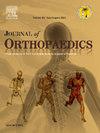模拟股骨骨折中远端皮质锁定与标准锁定螺钉固定的比较:生物力学荟萃分析
IF 1.5
Q3 ORTHOPEDICS
引用次数: 0
摘要
导言远皮质锁定(FCL)是锁定钢板固定的一种概念,它具有降低硬度和对称微动的特点,可改善胼胝体的形成。我们的研究旨在通过分析尸体和合成骨模型的研究,回顾评估 FCL 钢板和螺钉固定与标准锁定 (SL) 钢板和螺钉固定的生物力学数据,从而得出生物力学结论。方法对模拟股骨骨折的 FCL 和 SL 钢板固定进行比较的生物力学研究进行了回顾,以了解构造刚度、破坏荷载、近皮质和远皮质的轴向运动以及近皮质和远皮质轴向运动的差异,从而证明运动的对称性。在近皮层,FCL 的轴向运动比 SL 大 0.425 毫米(95 % CI 0.359 至 0.491,p = 0.001),在远皮层,FCL 的轴向运动比 SL 大 0.456 毫米(95 % CI 0.378 至 0.534,p = 0.001)。FCL 导致对称运动,远皮层和近皮层之间无显著差异,远皮层比近皮层位移多 0.347 毫米(95 % CI -0.038 至 0.731,p = 0.78)。SL导致不对称运动,偏向远侧皮层 0.270 mm (0.096-0.443, p = 0.002)。结论股骨骨折的 FCL 螺钉固定实现了降低结构僵硬度和促进更对称轴向运动的目标,同时保持了结构强度。这些结果支持远端皮质锁定的整体生物力学目标,并鼓励研究其对临床和影像学结果的影响。本文章由计算机程序翻译,如有差异,请以英文原文为准。
Far cortical locking versus standard locking screw fixation in simulated femoral fractures: A biomechanical meta-analysis
Introduction
Far cortical locking (FCL) is a concept of locking plate fixation with reduced stiffness and symmetric micromotion to improve callus formation. The goal of our study was to review biomechanical data evaluating FCL plate and screw fixation versus standard locking (SL) plate and screw fixation by analyzing studies of cadaveric and synthetic bone models to draw biomechanical conclusions.
Methods
Biomechanical studies that compared FCL and SL plate fixation for simulated femoral fractures were reviewed for construct stiffness, load to failure, axial motion at the near and far cortices, and the difference between near and far cortical axial motion to demonstrate motion symmetry.
Results
FCL decreased stiffness by 1.069 kN/mm compared to SL (95 % CI 0.405 to 1.732, p = 0.002). FCL demonstrated greater axial motion than SL in the near cortex by 0.425 mm (95 % CI 0.359 to 0.491, p < 0.001) and in the far cortex by 0.456 mm (95 % CI 0.378 to 0.534, p < 0.001). FCL resulted in symmetric motion with no significant difference between far and near cortices with the far cortex displacing 0.347 mm more than near (95 % CI -0.038 to 0.731, p = 0.78). SL resulted in asymmetric motion favoring the far cortex by 0.270 mm (0.096–0.443, p = 0.002). Construct strength was not significantly different with FCL load to failure 0.367 kN greater than SL (95 % CI -0.762 to 1.496, p = 0.524).
Conclusion
FCL screw fixation in femoral fractures achieves the goals of reducing construct stiffness and promoting more symmetric axial motion while maintaining construct strength. These results support the overall biomechanical goals of far cortical locking and should encourage investigation into its effects on clinical and radiographic outcomes.
求助全文
通过发布文献求助,成功后即可免费获取论文全文。
去求助
来源期刊

Journal of orthopaedics
ORTHOPEDICS-
CiteScore
3.50
自引率
6.70%
发文量
202
审稿时长
56 days
期刊介绍:
Journal of Orthopaedics aims to be a leading journal in orthopaedics and contribute towards the improvement of quality of orthopedic health care. The journal publishes original research work and review articles related to different aspects of orthopaedics including Arthroplasty, Arthroscopy, Sports Medicine, Trauma, Spine and Spinal deformities, Pediatric orthopaedics, limb reconstruction procedures, hand surgery, and orthopaedic oncology. It also publishes articles on continuing education, health-related information, case reports and letters to the editor. It is requested to note that the journal has an international readership and all submissions should be aimed at specifying something about the setting in which the work was conducted. Authors must also provide any specific reasons for the research and also provide an elaborate description of the results.
 求助内容:
求助内容: 应助结果提醒方式:
应助结果提醒方式:


